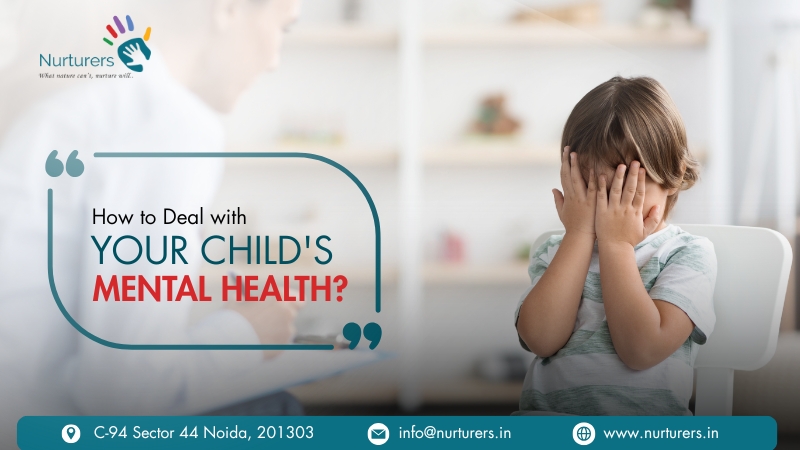Modern parenting is about more than just physical health and good grades—it’s about nurturing the invisible part of your child’s life: mental and child health. Good child’s mental health shapes how children learn, connect with others, and handle life’s challenges. But many parents don’t know what to look for, what causes mental health issues, or how to help.
If signs of persistent anxiety, mood changes, or withdrawal appear, seeking guidance from mental health professionals can provide effective coping strategies and treatment options. Remember, understanding, patience, and timely support are key to helping your child thrive emotionally and mentally.
What is mental health?
Mental health refers to a person’s emotional, psychological, and social well-being. It affects how we think, feel, and act, and plays an important role in how we handle stress, relate to others, and make choices in daily life. Good mental health doesn’t mean feeling happy all the time. Instead, it means being able to experience a range of emotions, cope with challenges, and function well in everyday activities. Mental health is just as important as physical health, and caring for it is essential at every stage of life — from childhood and adolescence through adulthood.
- The ability to understand and manage emotions like anger, anxiety, and disappointment.
- Building healthy friendships and social skills.
- Developing positive self-esteem and a sense of belonging.
- Coping with daily stress and changes without becoming overwhelmed.
- Staying motivated, curious, and focused in school and play.
Why do children develop mental health problems?
It’s natural for parents to ask: Why is this happening to my child? The truth is, mental health challenges rarely come from just one reason. Instead, they usually develop because of a mix of factors: a child’s temperament or brain chemistry, family stress, major life changes, trauma, academic pressure, or even long-term illness.
For example, a sensitive child might struggle more with bullying; a child with a family history of anxiety may be more vulnerable to worries; and big transitions—like changing schools or parents separating—can trigger sadness or fear. Environmental factors, such as living in an unpredictable or unsafe home, can also play a big role in shaping a child’s emotional health.

What mental disorders can affect children?
Mental health struggles in children are more common than many realize. They’re not signs of weakness but real conditions shaped by biology, environment, and experience. These can affect learning, friendships, and daily happiness.
Some common mental disorders include:
- Anxiety disorders: Anxiety disorders are more than normal worry—they involve persistent fears, physical symptoms, refusal to go to school, or avoiding social activities.
- Depression: Ongoing sadness, irritability, loss of interest in play or friends, low energy, and sometimes talk of hopelessness.
- ADHD: Trouble focusing, impulsivity, restlessness, or being constantly “on the go” are common signs of Attention Deficit Hyperactivity Disorder.
- Autism Spectrum Disorder (ASD): Challenges in social skills, flexibility, intense interests, and sensitivity to sound or touch are common signs of Autism Spectrum Disorder
- Obsessive-Compulsive Disorder (OCD): Unwanted thoughts and repetitive rituals like excessive handwashing or checking.
- Post-Traumatic Stress Disorder (PTSD): Nightmares, flashbacks, avoidance of reminders, and being easily startled after trauma.
- Behavioral or conduct disorders: Aggression, frequent defiance, breaking rules, or lack of empathy.
Recognizing these early helps children get support, learn coping skills, and feel happier and more secure.

Signs of mental health conditions in children
Children often express emotional struggles differently than adults, and these signs can show up in many ways—not just words. Recognizing them early is the first step in getting help.
- Changes in mood: Persistent sadness, irritability, frequent anger outbursts, or unexplained mood swings lasting for weeks.
- Withdrawal: Losing interest in friends, family time, hobbies, or activities they once enjoyed.
- Behavior changes: Acting out at school or home, becoming unusually clingy, aggressive, or defiant.
- Academic decline: Drop in grades, trouble concentrating, daydreaming, or seeming restless in class.
- Physical complaints: Recurring headaches, stomachaches, nausea, or unexplained aches—often linked to emotional distress.
- Sleep and appetite changes: Trouble falling asleep, frequent nightmares, oversleeping, loss of appetite, or overeating.
- Excessive fears or worry: Fear of being alone, fear of the dark, fear of school, or worrying constantly about everyday situations.
- Low self-esteem or hopelessness: Negative self-talk, feeling “not good enough,” or saying things like “no one likes me.”
- Risk-taking or self-harm: Talking about wanting to disappear, harming themselves, or sudden risky behavior beyond age-appropriate curiosity.
These signs don’t always mean a child has a mental health disorder—but if they’re persistent, intense, or affect daily life, it’s important to reach out for professional help. Early recognition and support can help children build resilience, feel understood, and prevent challenges from growing bigger over time.

Causes of mental health in children
Children’s mental health challenges don’t appear without reason—they’re often shaped by a complex mix of biology, environment, and life experiences. Understanding the causes of mental health conditions can help parents respond with empathy and take steps to prevent or reduce risk.
Biological and genetic factors
- Children with a family history of mental health conditions like anxiety, depression, or ADHD have a higher chance of developing similar challenges.
- Differences in brain chemistry or development, including how the brain processes emotions, can also play a role.
- Some prenatal factors—such as maternal stress, illness, or exposure to substances during pregnancy—may influence brain development.
Family and home environment
- Parental conflict, divorce, or separation can create chronic stress for a child.
- Experiences of neglect, harsh punishment, or inconsistent parenting can make it hard for children to feel safe and understood.
- A home environment lacking emotional support or open communication can increase a child’s vulnerability to stress.
Stressful life events and trauma
- Events like the death of a loved one, witnessing violence, bullying at school, or serious accidents can deeply impact a child’s mental health.
- Even moving to a new school or city can be a significant source of anxiety for some children.
Academic and social pressures
- The pressure to achieve high grades, excel in extracurricular activities, or fit in socially can lead to feelings of inadequacy and anxiety.
- Repeated experiences of peer rejection, teasing, or bullying can harm self-esteem and emotional well-being.
How is children’s mental health assessed?
Assessing a child’s mental health is a careful and holistic process designed to truly understand what the child is experiencing, rather than simply labeling behavior. It usually begins with detailed conversations between mental health professionals, the child, and their parents or caregivers. These conversations explore the child’s feelings, daily routines, relationships, challenges at school, and family dynamics. Alongside these interviews, professionals often observe how the child interacts with others—in the clinic, at school, or sometimes at home—to see firsthand how emotions and behavior show up in different settings.

Which therapy helps Child's Mental Health?
Several therapies have been proven to help improve a child’s mental health, depending on the specific challenges they face. Here are some of the most effective ones:
- Cognitive Behaviour Therapy (CBT):
Cognitive Behaviour Therapy is one of the most researched and widely used therapies for children. It helps them understand and manage negative thoughts, learn coping strategies, and change unhelpful behaviors. It is especially effective for anxiety, depression, and some behavioral issues. - Play Therapy:
Play Therapy is designed especially for younger children who may not be able to express their feelings in words. Through play, therapists help children explore emotions, resolve conflicts, and develop problem-solving skills. - Behavioural Therapy:
Behavioural Therapy focuses on encouraging desired behaviors and reducing harmful or disruptive behaviors. It is often used for ADHD and conduct disorders. - Family Therapy:
Family Therapy involves parents and sometimes siblings. It helps improve family communication, strengthen relationships, and create a supportive home environment - Art and Music Therapy:
Art Therapy uses creative expression as a way to explore feelings and reduce stress, especially for children who find verbal communication difficult. - Group Therapy:
Gives children the opportunity to connect with peers facing similar challenges, which can help reduce feelings of isolation and build social skills.
Each child is unique, so therapists often combine these approaches to best support the child’s mental health. If you’d like, I can also help explain which therapy might suit specific conditions (like anxiety, ADHD, or trauma).

How to improve child mental health at home
Improving your child’s mental health at home is both possible and very impactful. Small, everyday actions and an emotionally supportive environment make a big difference. Here are some practical ways you can help:
- Build a strong emotional connection
Spend quality time together—listen, talk, and show genuine interest in your child’s feelings and thoughts. Feeling heard and understood builds trust and emotional security. - Encourage open communication
Create a home where it’s safe to talk about feelings without fear of judgment. Teach your child to name and express their emotions in words. - Maintain a predictable routine
Consistency helps children feel safe. Regular sleep, meals, and study or playtime provide structure that supports emotional well-being. - Promote healthy lifestyle habits Balanced nutrition, daily physical activity, and good sleep hygiene directly affect mood and stress levels.

Supporting your child beyond home
In addition to family care, professional and community resources help build resilience:
School counselors: Offer strategies and watch children’s daily progress.
Mental health programs: Group sessions on social-emotional skills, mindfulness, and self-esteem.
Community workshops and parenting classes: Teach parents positive discipline and stress management.
Support groups: Reduce isolation for parents and children facing similar challenges. Seeking help shows strength—not failure.
Why early help matters
Children’s brains are still developing. Early, supportive care can:
- Improve academic success and relationships
- Prevent symptoms from worsening into adulthood
- Strengthen emotional regulation and self-esteem
- Reduce risky behaviors later in life
The earlier we act, the greater the chance of lifelong health and happiness.
Conclusion
Mental and child health is too important to ignore. By understanding the child mental health definition, learning about the causes of mental health issues, exploring professional mental health programs, and creating a loving, structured home, parents become their child’s greatest source of strength.
Remember: your love and awareness are powerful tools. And if you see signs of distress, don’t wait—reach out for professional help. Together, we can give every child the gift of mental wellness and hope.

